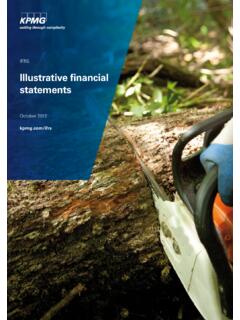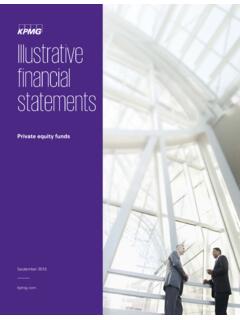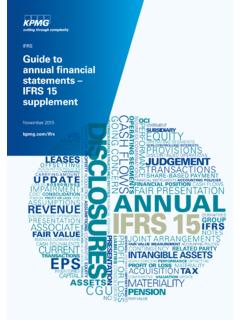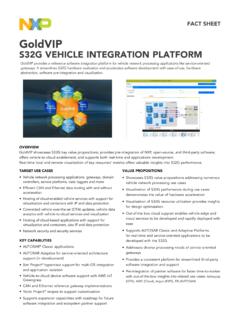Transcription of Framing a winning data monetization strategy - KPMG
1 Framing a winningdata many forward looking organizations across the globe, an immediate and evolving new front of competitiveness, data monetization , is being added to the C-Suite and Board agendas. Highly competitive and innovative companies constantly seek new competitive grounds and explore new paths to success. The recent advent of the technological advancements in Big data and analytics has paved the road to a new era of competitiveness; an era where data is viewed strategically and as a living and evolving asset, an asset that can unleash new opportunities for monetization . The use of data and analytics to enhance decisions is not new or novel. The new frontier is exploiting and monetizing data in a coordinated and organization-wide manner to strategically advance our competitive advantage; a strategic goal that demands a strategic approach and framework.
2 This document offers a dynamic framework for developing a winning data monetization strategy a framework that considers the varying data sources, offers a process for recognition of value, presents applicable business model options, explores commercialization alternatives and points to the various challenges to be addressed. Framing a winning data monetization strategy1 / Framing a winning data monetization strategy 2015 KPMG International Cooperative ( KPMG International ). KPMG International provides no client services and is a Swiss entity with which the independent member firms of the KPMG network are a winning data monetization strategy / 2 Foremost, it is nOT about information technology or business monetization is about effective and timely exploitation of an ever-growing new class of asset, the enterprise data , and converting that asset into currency (profits) by increasing revenues or decreasing costs.
3 It is true that this asset ( data ) is generated through deployment of technology; however, monetization of this critical asset is most definitely a business challenge. Technology will help collect, store, and deliver the data ; advanced analytics will help explore the data and discover strategic and transactional value. But it is a sound strategy , followed by an effective business model, which helps the enterprise focus on creating value from data and analytics , effectively monetize the asset and create a competitive advantage for the enterprise. Business intelligence (BI) solutions, tools, and dashboards that deal with packaging and visualizing historical performance data to support decisions are hugely valuable to the day to day management of the operations.
4 An effective data monetization strategy is however not about tools, the underlying technologies or the tactical management of the enterprise. As an analogy, if we view BI tools and databases as the pipelines and the data as the electricity that flows through it; although an effective pipeline is important to delivering electricity, it is the electricity that is monetized (sold) and not the pipeline network. data monetization strategies are indeed influenced by technological capabilities of an enterprise, however the starting focus for strategy formulation should be on defining the value to the enterprise, the value to its customers, and the potential value to third parties in its immediate or adjacent industries.
5 It is about monetizing data or transforming this corporate asset into currency, profits, and market advantage, and not about optimizing servers and databases, data mining, or dicing and slicing past performance information to support tactical , it is about how you look at the enterprise as a LIVING entity and data as an most corporate assets, data is constantly evolving, and it may be both appreciating and depreciating simultaneously. While historical data may lose value with respect to short cycled transactional opportunities, it may be gaining value from a trending and long cycle strategic perspective. As an organization operates, it generates data . And as its environment and competitors interact and evolve with each other and with customers, more and more data is generated.
6 A framework to effectively monetize this constantly changing asset ( data ) must recognize the dynamic nature of the asset. The monetizing assumptions and plans should recognize and be responsive to the constantly growing and changing nature of data as well as how it may be generated and consumed. A key step towards recognizing the evolving nature of this fluid, dynamic, and ever-growing asset is to appreciate that the organization that generates this asset is also ever-changing and growing. An enterprise that can be viewed as a LIVING organism. An entity that consumes cash and produces services/products, profits/losses, and waste. Its soul is its culture. Its nervous system is the measurement and communications network overlaid upon it.
7 The synapses and data contain signals of opportunities, risks, performance, and efficiencies from across the body of the enterprise and from its environment. As a LIVING entity, the enterprise needs a living and exertive strategy that is adaptive to the challenges it constantly faces. The evolution of a living entity and its mutation towards an improved being is a function of how quickly it can sense and respond to danger ( capture the data , analyze it, and extract actionable insights from it), as well as how fast it acclimates to new sets of challenges ( finding an improved focus for the strategy and a responsive rhythm in execution).To effectively strategize around leveraging data to its advantage, corporate leadership should recognize the fluidity of data across the enterprise, data s ability to connect the enterprise together, and the embedded value contained in the signals it may carry.
8 Other factors to consider are data s ever-evolving and changing characteristics, and its ability to create value as the context of the evaluation shifts or when placed alongside other data (internal or external).So, what is data monetization all about? 2015 KPMG International Cooperative ( KPMG International ). KPMG International provides no client services and is a Swiss entity with which the independent member firms of the KPMG network are enterprise that does not effectively utilize its data assets can be compared to a living entity with a broken nervous and sensory system. A living enterprise that suffers from compromised abilities to hear, feel, see, and smell the dangers and opportunities around is vulnerable and disabled.
9 The lack of a working nervous system that can help the brain make the right decisions at the right time leaves a living entity exposed. The return on data , this unrecognized asset on the balance sheet, is a superior competitive position that can be shaped based on the intelligence and insight it offers the enterprise. In the new era of Big data , this asset can potentially provide a very differentiating competitive arriving at the value of any piece of machinery one considers utilization; when evaluating liquid assets, one considers the annualized returns; when pricing real estate assets, one accounts for occupancy rates as well as maintenance factors and market dynamics; when assessing value of inventory, it may be a function of market or a rollup of material and labor and indirect costs.
10 When valuing data , one must not only consider the use case, but also factor in freshness, its value when connected to other data within or external to the enterprise, the evolution path (does the value increase over time), dynamic and evolving view of an enterprise is the foundation of the Exertive strategy Concept (ESC), a conceptual perspective that facilitates the formulation and execution of dynamic strategies that are powered by data analytics . It is an approach that leverages the data assets within and external to the enterprises, recognizes the continuous shifts of the competitive forces and the ecosystem, considers challenges of execution across the value chain, and examines effectiveness from a connected enterprise point of view balancing growth, risk, and efficiency.













